|
|
|
Sort Order |
|
|
|
Items / Page
|
|
|
|
|
|
|
| Srl | Item |
| 1 |
ID:
159970
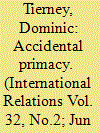

|
|
|
|
|
| Summary/Abstract |
Why did states fail to balance against the United States after the end of the Cold War? Scholars have neglected an important dynamic: the accidental nature of America’s rise to primacy. The United States became the sole superpower not by deliberately increasing its capabilities but due to the unexpected collapse of its rival, the USSR. The case illustrates that a state’s responsibility for its gains in power can vary significantly, with important consequences for subsequent balancing. Active or deliberate power increases tend to produce more balancing than passive power increases because they signal aggressive intentions, alter the dyadic power balance between the rising state and potential balancers, and trigger loss aversion.
|
|
|
|
|
|
|
|
|
|
|
|
|
|
|
|
| 2 |
ID:
128739


|
|
|
|
|
| Publication |
2014.
|
| Summary/Abstract |
In this article I view Asian alliances as a product of universal security needs and culturally constructed variables. While the alliance remains one of the fundamentals of contemporary international politics, I attempt to show through comparative analysis of the Sino-Soviet alliance and the Japan-US security alliance how subtle differences of national developmental experience can significantly affect political outcomes in East Asia.
|
|
|
|
|
|
|
|
|
|
|
|
|
|
|
|
| 3 |
ID:
103196


|
|
|
|
|
| Publication |
2011.
|
| Summary/Abstract |
The present paper seeks to make sense of recent European Union (EU) naval capability changes by applying neo-realist theory to the EU as a collective actor in the global balance of power. The paper compares two different strands of neo-realist theory by deducing key predictions about the expected naval posture of the Union and the corresponding expected changes in capabilities. These predictions are subsequently held up against post-cold war data on naval acquisitions in the EU. The paper concludes that the observed patterns are best explained not as bandwagoning with the USA, but as a long-term balancing strategy aimed at bolstering the autonomy and international influence of the Union vis-a-vis other major powers, including the USA.
|
|
|
|
|
|
|
|
|
|
|
|
|
|
|
|
| 4 |
ID:
141654
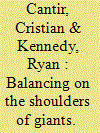

|
|
|
|
|
| Summary/Abstract |
“Soft balancing” has emerged as a way to reconcile realist theory with the lack of hard balancing behavior against US hegemony. Scholars continue, however, to disagree on the concept's utility and causes. Consistent with its realist roots, scholars have primarily focused on power imbalance and external threat to security as causes of soft balancing. This article analyzes Moldova's major foreign policy shift in the mid-2000s. It argues that this was a clear example of soft balancing and that it adds several important insights into the causes of soft balancing. While the power imbalance and external threat from Russia were persistent throughout Moldova's post-independence history, the country only adopted a soft balancing strategy once Russia posed a threat to the internal stability of the government and changes in EU policy created a permissive international environment for the strategy. Moreover, we argue that the domestic political environment played a key role in enabling the adoption of this strategy. This article therefore diversifies the analysis of the causes of soft balancing and provides a theoretical answer for the puzzle of Moldova's pro-Western turn in 2003.
|
|
|
|
|
|
|
|
|
|
|
|
|
|
|
|
| 5 |
ID:
159414


|
|
|
|
|
| Summary/Abstract |
The foreign policy of Ceylon under the premiership of D.S. Senanayake maintained
a distinct alignment with its former coloniser Great Britain. The zenith
of this relationship was the defence agreement which came into effect upon
independence in 1948. Utilising the existing scholarship on neorealism and the
concept of security dilemma, analysis of the reasons behind this strategic alignment
exposes the threat perception Ceylon faced from its regional hegemon,
India. This study surveys such threat perceptions faced by the island at the time
of independence and argues that this led to a balancing strategy with Britain. It
first locates Ceylon’s foreign policy employing the taxonomies of balancing, bandwagoning
and hedging and then examines how Ceylon’s extra-regional alignment
with the UK enabled her to eschew from a security dilemma with India.
|
|
|
|
|
|
|
|
|
|
|
|
|
|
|
|
| 6 |
ID:
150648
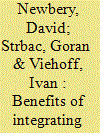

|
|
|
|
|
| Summary/Abstract |
The European Commission's Target Electricity Model (TEM) aims to integrate EU electricity markets. This paper estimates the potential benefit of coupling interconnectors to increase the efficiency of trading day-ahead, intra-day and balancing services across borders. Further gains are possible by eliminating unscheduled flows and avoiding the curtailment of renewables with better market design. In the short run the gains could be as high as €3.9 billion/yr, more than 100% of the current gains from trade. About one-quarter of this total comes from day-ahead coupling and another third from shared balancing. If shared balancing is so valuable, completing the TEM becomes more urgent, and regulators should ensure these gains are paid to interconnectors to make the needed investment in the cross-border links more commercially profitable.
|
|
|
|
|
|
|
|
|
|
|
|
|
|
|
|
| 7 |
ID:
173190
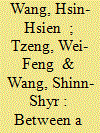

|
|
|
|
|
| Summary/Abstract |
In comparison to hegemony, lesser powers usually struggle for survival between two or more great powers under state power asymmetry, a perpetual phenomenon in international politics. With the rise of China and the increasingly strengthening role of the US in the Asia-Pacific region, it is important to learn how lesser powers manage their relations with the two. To explore this issue, we propose that the strength of state power will constrain the strategies of lesser powers as they choose between the US and China. Borrowing from existing theories and ideas on strategies that include balancing, bandwagoning, and hedging, we argue that the stronger a country’s power, the more likely it will choose a balancing strategy. At the same time, the weaker the country, the more likely that it will go with bandwagoning. Regional middle powers will show varied strategy choices, as they possess a higher degree of freedom in choosing which great power to side with. To validate these arguments, we construct two indicators — differences in trade dependence on the US and China and differences in the voting score consistent with the US and China — to quantify the strategies of lesser powers toward great powers and examine whether the variable of strategies follows the expected pattern. Our analysis shows that countries in the middle of the spectrum of state power demonstrated great freedom in choosing strategies toward the two powers.
|
|
|
|
|
|
|
|
|
|
|
|
|
|
|
|
| 8 |
ID:
112423
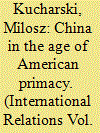

|
|
|
|
|
| Publication |
2012.
|
| Summary/Abstract |
Recent literature on soft balancing predicts an increased occurrence of soft balancing against Washington at times when the United States acts unilaterally in foreign policy. At the same time, realist literature in IR suggests that interest violations should trigger opposition by states whose interests are being violated, unless there are unacceptable costs associated with soft balancing. In contrast to these views, this article demonstrates that interest violation and unilateralism, both individually and together, are weak predictors of soft balancing. Instead, based on the cases analyzed, I argue that soft balancing is most likely to occur when interest violations go hand in hand with perceptions of predatory intentions.
|
|
|
|
|
|
|
|
|
|
|
|
|
|
|
|
| 9 |
ID:
148224
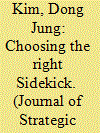

|
|
|
|
|
| Summary/Abstract |
Scholars and practitioners of grand strategy agree that the use of military force should be supplemented by appropriate economic policies. However, strangely few accounts of economic complements to military grand strategies have been presented in recent discourse on US grand strategy. This paper takes a first step to fill this information gap. I first assess the role that could be played by economic measures under two types of grand strategies – one focusing on the balance of power and the other emphasising influence and order. Second, I introduce what I call ‘the influence-capability dilemma’ and discuss tradeoffs in adopting certain economic policies in order to help the US sustain pre-eminence in the international system. Third, I discuss how the US should address this dilemma of economic means in dealing with the rising China.
|
|
|
|
|
|
|
|
|
|
|
|
|
|
|
|
| 10 |
ID:
162890


|
|
|
|
|
| Summary/Abstract |
This article discusses a new method for the sizing of operating reserves by electric power system operators. Operating reserves are used by system operators to deal with unexpected variations of demand and generation, and maintain a secure operation of the system. This becomes increasingly challenging due to the increasing share of renewable generation based on variable resources. This paper revisits the current sizing method applied in Belgium, which is based on a static approach that determines the required capacity once a year. The presented dynamic sizing method determines the required capacity on a daily basis, using the estimated probability of facing a system imbalance during the next day. This risk is estimated based on historical observations of system conditions by means of machine learning algorithms. A proof of concept is presented for the Belgian system, and demonstrates that the proposed methodology improves reliability management while decreasing the average capacity to be contracted. The method is compliant with European market design, and the corresponding regulatory framework, and is of particular interest for systems with a high share of renewable generation. For these reasons a gradual implementation in Belgium towards 2020 has been decided based on the results of this study.
|
|
|
|
|
|
|
|
|
|
|
|
|
|
|
|
| 11 |
ID:
192074
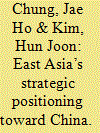

|
|
|
|
|
| Summary/Abstract |
Relatively few systematic and categorical studies have been conducted on the variant responses by East Asian states to the rise of China, and even fewer dealt with reasons for such intra-regional variations. This study seeks to fill the void by examining the strategic responses by 15 East Asian states for the period of 2011–2016. This period merits close scrutiny because China became more explicitly assertive. The research proceeds in two phases. First, by way of reading into the expert assessments in academic journals, the strategic responses of the 15 states are categorised into balancing, hedging, or bandwagoning. Second, statistical analyses are conducted to see how the intra-regional variations are related to unit-level factors. Of the seven variables analyzed, three – geographical proximity, democracy, and identity – turn out to be crucial in determining the East Asian states’ strategic responses.
|
|
|
|
|
|
|
|
|
|
|
|
|
|
|
|
| 12 |
ID:
090277


|
|
|
| 13 |
ID:
122923
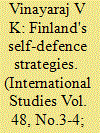

|
|
|
|
|
| Publication |
2011.
|
| Summary/Abstract |
The essay examines the threats and challenges that Finland has perceived first from imperial Russia, then from the Soviet Russia and now from the Russian Federation. Apart from studying the dynamics of Finland-Russia relations, it looks specifically at the Finnish responses for ensuring its sovereignty, independence and territorial integrity in general and the self-defence strategies adopted by Finland in dealing with potential threats from Russia in particular. This is done in the context of Paul Schroeder's categorization of self-defence strategies.
|
|
|
|
|
|
|
|
|
|
|
|
|
|
|
|
| 14 |
ID:
104056


|
|
|
|
|
| Publication |
2011.
|
| Summary/Abstract |
This article examines how geopolitical shifts and the potential emergence of either a bipolar or multipolar system will affect the transatlantic relationship and a small state on the margins of power centres. A more Asia-centred world and a new polarity could drive a wedge into the transatlantic relationship. It is therefore explored how the US and the EU can develop hedging and risk management strategies that are complementary and take into account diverging capabilities, political structures, different threat perceptions of China and the effects of a potential new polarity. It is also noted that Norway will need a sophisticated foreign policy if it wants to approach the EU's position related to China, while simultaneously sustaining close relations with a US that is becoming more preoccupied with China and continues to shift more of its resources towards Asia. A hedging strategy can guide Norwegian policy-makers to meet such challenges.
|
|
|
|
|
|
|
|
|
|
|
|
|
|
|
|
| 15 |
ID:
123108


|
|
|
|
|
| Publication |
2013.
|
| Summary/Abstract |
In the face of a rising China, some scholars have argued that ASEAN countries will choose to either bandwagon with or balance against China, while others believe they will respond with a more moderate policy known as 'hedging'. In considering these options, ASEAN countries must take into account their individual interests within the economic and security structure of this region. In this research, we argue that each ASEAN country confronts divergent sets of security and economic relations with China, which play a major role in shaping their policy responses. We can characterize their responses into four quadrants. Each cell can be categorized in terms of a high or low degree of threat perception (HT or LT) from China, as well as a positive or negative economic expectation (PE or NE) with China. We thus hypothesize that ASEAN countries in the HT-NE situation will balance against China; those in the LT-PE situation will bandwagon with China; those in the HT-PE or LT-NE situations will hedge against China. Hypotheses are supported by three case studies, Vietnam-China (HT-NE), Cambodia-China (LT-PE) and Singapore-China (HT-PE) relations.
|
|
|
|
|
|
|
|
|
|
|
|
|
|
|
|
| 16 |
ID:
162429
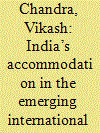

|
|
|
|
|
| Summary/Abstract |
This article has two-fold goals: to develop a coherent concept of accommodation and explicate variable shaping the process of accommodation; and to analyse and evaluate the challenges and prospects of India’s accommodation in the emerging international order. It defines accommodation as a ‘state strategy’ and ‘process’. It figures out six determinants viz. the sphere of influence, structural variables, convergence/divergence of national interest, perception and intention towards the international order, political and socio-cultural values, and costs of non- accommodation. Instead of addressing the process of accommodation from accommodation-seekers’ perspective, the article investigates the issue from accommodators’ perspective. Therefore, rather than describing traditional foundations of India’s claim of accommodation, i.e. population, territory, military, and democracy, it illustrates conditions under which the established power accommodate rising powers. By comparing and contrasting India’s interests, principles, and values vis-à-vis the USA and China, it demonstrates how differing strategic calculations, economic and commercial interests and divergence in political socio-cultural norms and values, China is posing or may pose challenges to India’s accommodation. It suggests that India needs to strike a balance between the declining America and rising China. It will have to learn how not to turn China from an adversary to an enemy. A prudent strategy for India will be to balance China, however, in the non-military, i.e. diplomatic, political and economic realms. Nevertheless, the engagement dimension should not be marginalised, actual or even perceived.
|
|
|
|
|
|
|
|
|
|
|
|
|
|
|
|
| 17 |
ID:
188451
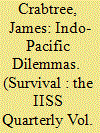

|
|
|
|
|
| Summary/Abstract |
The United States intends to manage China’s rise by forging a new balancing coalition of ‘like-minded’ partners and by developing deeper ties with other nations in the Indo-Pacific that view themselves as broadly non-aligned. Washington hopes that closer ties to the US and its partners will stop such countries from drifting towards China. But to create these deeper relationships, the non-aligned group also needs reassurance that attempts by the like-minded partners to integrate capabilities and fashion a new regional balance of power will not tip the Indo-Pacific towards conflict. Like-minded nations will need to appreciate the risks that security initiatives like the Quad and AUKUS are perceived to create, realise that Hanoi or Jakarta is unlikely to embrace Canberra’s or Tokyo’s vision of the region’s future warmly, and be willing to make substantial material investments. Tension between integration and reassurance will inevitably endure.
|
|
|
|
|
|
|
|
|
|
|
|
|
|
|
|
| 18 |
ID:
160014
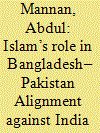

|
|
|
|
|
| Summary/Abstract |
This article engages with Bangladesh’s policy of seeking alignment with Pakistan, pursued by the Bangladesh Nationalist Party (BNP) government in different tenures from the 1990s on. In this endeavour, the article takes into account the BNP’s politics of Islamic identity as a key variable of analysis. This identity factor tacitly presents Bangladesh, Pakistan and India as ‘Muslim Bangladesh’, ‘Muslim Pakistan’, and ‘Hindu India’, respectively. It frames ‘Muslim Pakistan’ as a mutual ally of ‘Muslim Bangladesh’ and shares with Pakistan a view of ‘Hindu India’ as the enemy-other. It operates in foreign policy through domestic politics in Bangladesh, wherein for the BNP, being anti-Indian is synonymous with being pro-Islam. It is claimed in this article that this politics of Islamic identity draws Bangladesh into an alignment with Pakistan, dragging Bangladesh into Pakistan’s own conflict with India.
|
|
|
|
|
|
|
|
|
|
|
|
|
|
|
|
| 19 |
ID:
129793


|
|
|
| 20 |
ID:
183251


|
|
|
|
|
| Summary/Abstract |
Kuwait has developed and earned a reputation as a mediator in regional affairs as leadership-level conceptions of ‘national’ and ‘regime’ security have intersected with pragmatic assessments of the benefits any such mediation would bring to Kuwait’s regional interests. As a small state in a volatile neighbourhood, such calculations have been accorded greater policymaking priority than any ideational attachment to mediation. Kuwait’s experience is nevertheless worthy of closer study for the lessons that can be drawn for other small states, especially those in the Gulf, which share broadly similar attributes to Kuwait in style of decision-making and the careful balancing of competing regional pressures.
|
|
|
|
|
|
|
|
|
|
|
|
|
|
|
|
|
|
|
|
|